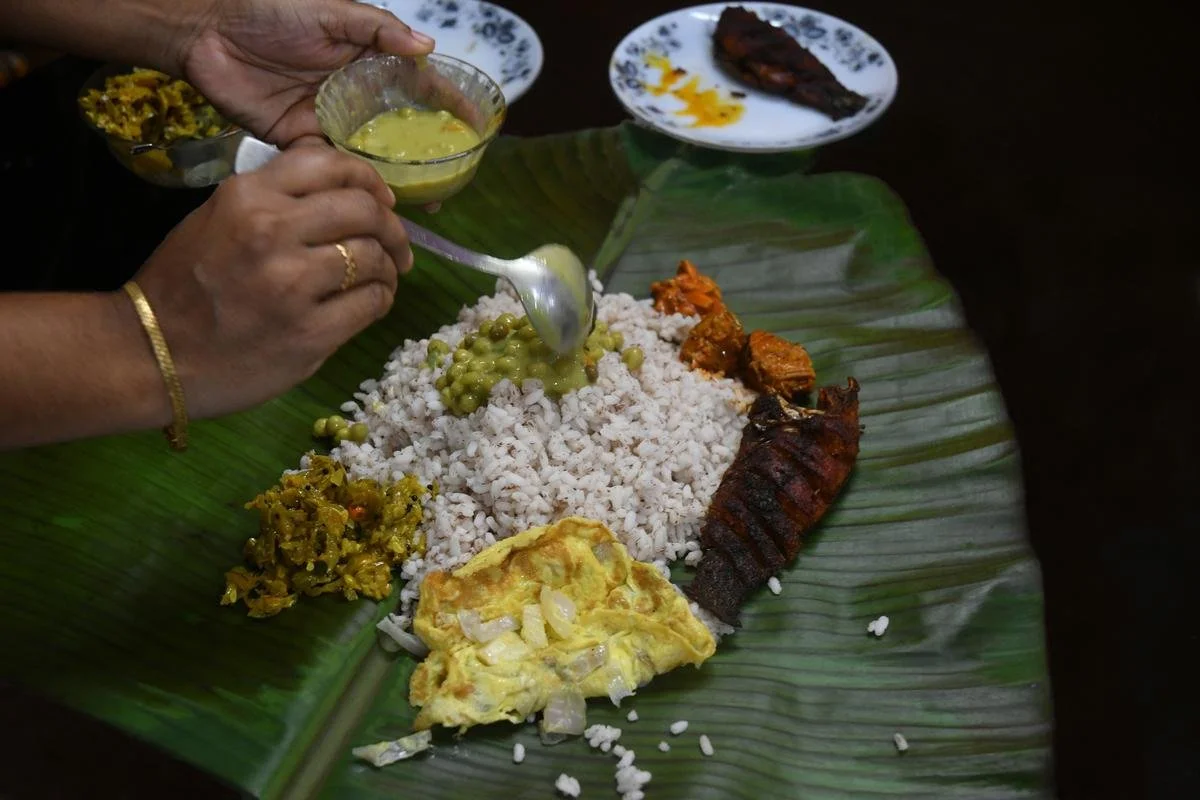A Guide to Making Homemade Sevai

Deepa Iyer is inducted into the family ritual of making sevai at age ten. Labour-intensive but rewarding, turning rice dough into strings of sevai is a family tradition that spans generations and countries. Recipe included!
I was ten when I first helped make sevai (homemade rice noodles) in my ancestral home in Thanjavur, and I derived great joy from feeling useful. Creating noodles was an intricate procedure in which a child could feel more than merely a burdensome mouth to feed. For generations, my great-grandmother, grandmother, mother, and aunts had manually stone-ground rice on the floor, steamed it into paste, and rolled it painstakingly into fine noodles (via an oblong copper machine akin to a pasta maker). They put me in charge of turning the sevai nazhai (sevai machine) round-and-round, tossing me the flattened misshapen, crispy edge-dough that oozed deliciously out of the machine’s top thanks to the churner’s friction. My great-aunt deftly spiced separate noodle piles (lemon and lentil, pepper and cumin, coconut and chilly), packing it into cozy metal tins.
We set off in a van, bumpily traversing pebble-filled streams, green paddy fields, and rust-coloured hills. Thanjavur district’s humid, sticky summer heat, the bats often swooping to shelter above ancient stone pillars in dark, twelfth-century temple halls, the suffocating crowds jostling to glimpse idols in inner sanctums: I have experienced these many times over the years. From that trip, I vividly remember the impatient, gnawing hunger of childhood, when traveling dusty roads to visit one temple after another, in one village and then the next.
Somewhere near Kumbakonam, the van stopped under a sprawling tree: the adults were no longer able to bear my whining. Flapping newspapers and pai mats were spread away from the roadside; out popped a couple of folding chairs and palmyrah fans for the elderly ladies, and—finally—parcels of baby mango pickles (mavudu) tucked in pillows of curd rice, a carefully covered clay pot of avial (coconut-and-vegetable stew), a container of fried appalams, and…a jute bag with the sevai-filled tins.
I opened the lid of my tin and relished salted, plain sevai (purposely de-spiced to suit my bland babyish tastes) while the adults ate their variously flavoured sevai: spicy lemon, coconut and chilly, and pepper-cumin. A gaggle of envious crows gathered, cawing imploringly in supplication, but our treasure was too delicious to share.
Making sevai is a labour-intensive but rewarding process that occurs in meditative, precise spurts. My family is one of global nomads, but we still stop occasionally to steam-grind out sevai and linger over the bounty. Here is a photo-recipe that demystifies how a ball of rice dough turns into multitudinous strings.
Recipe: Deepa Iyer’s Sevai
You will need a heavy bottomed pan, a few large mixing bowls, a pressure cooker, an idli pan, a sevai nazhi (sevai maker, available anywhere in Tamil Nadu or Karnataka), and a stone grinder.
Ingredients
2 cups parboiled rice (idli rice) (soaked for at least 5 hours or overnight)
2 cups water
3 tsp sesame oil
Salt (per taste – 1-2 tsp)
1. Soak 2 cups parboiled rice/ idli rice for at least 5 hours or overnight.
Wash and grind till smooth in a Priya stone grinder; it may be possible to use a very high powered blender as well. Add salt as per taste.
2. Pour 2 cups water to make a consistent wet mixture; mix well.
3. In a heavy-bottomed pot or non-stick pot add 3 teaspoons sesame oil and add this rice mixture. Keep stirring constantly until it thickens and cooks. It will look glazed initially then stiffen into a sticky dough.
4. Boil water in a pressure cooker and oil an idli plate. Make balls of the rice mixture and place it in the idli plate. Cover pressure cooker and steam for 15 minutes.
5. While hot, stick one ball at a time inside the sevai nazhi and turn the handles to squeeze out noodles onto a plate.
6. Separate sevai into portions and mix with the different kinds of seasoning.
Lemon Sevai
Ingredients
1-2 tsp mustard meeds
3 tsp chana dal
2 green chillies, chopped
6-8 fresh curry leaves
A pinch of hing
¼ tsp turmeric powder
Juice from 1-2 limes
2 tsp sesame oil
Salt to taste
Method
Heat sesame oil in a small pan and splutter mustard seeds when hot.
Add in and brown the channa dal until it is slightly reddish.
Add in green chillies, curry leaves, hing, turmeric and take the pan off the heat.
Add this seasoning to sevai; salt per taste.
Add the lime juice into the sevai and mix.
Pepper Jeera Sevai
Ingredients
2 tsp pepper
1 tsp cumin
2 tsp mustard seeds
6-8 fresh curry leaves
A pinch of hing
3 tsp ghee
Salt to taste
Method
Grind pepper and cumin coarsely in a spice grinder.
Heat ghee in a small pan and splutter the mustard seeds when hot.
Add curry leaves, ground pepper-jeera powder, and a pinch of hing.
Add this seasoning to sevai; salt per taste and mix.
Coconut Chilly Sevai
Ingredients
20 raw cashews
3 tsp urad dal
1-2 cups fresh grated coconut
4 dried red chillies
6-8 fresh curry leaves
A pinch of hing
2 tsp mustard seeds
4 tsp ghee
Salt to taste
Method
Roast handful of cashews to slightly reddish brown colour in 2 tbsp ghee. Set aside.
Sputter mustard seeds in 2 tbsp ghee.
Add 3 teaspoons urad dal and let it change to reddish brown colour.
Add 4 red chillies, curry leaves and hing.
Add the grated coconut and roast until grated coconut is slightly browned.
Add to sevai with salt to taste and mix.
Deepa is always hungry and loves to graze, whether in Thanjavur, Bangalore, San Francisco, or London. She works at Omidyar Network, a global impact investing firm.
ALSO ON THE GOYA JOURNAL














